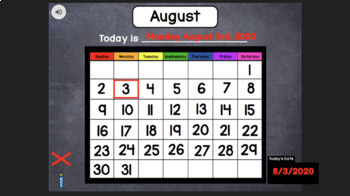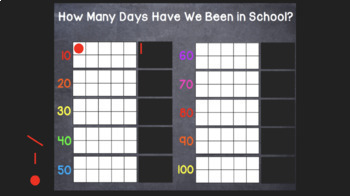2020-2021 Digital Google Slide Calendar
KinderCulture
278 Followers
Grade Levels
PreK - 2nd
Subjects
Resource Type
Standards
CCSSK.CC.A.1
CCSSK.CC.A.2
CCSSK.NBT.A.1
CCSSRF.K.3c
NGSSK-ESS2-1
Formats Included
- Google Slides™
- Internet Activities
Pages
20 pages
KinderCulture
278 Followers

Made for Google Drive™
This resource can be used by students on Google Drive or Google Classroom. To access this resource, you’ll need to allow TPT to add it to your Google Drive. See our FAQ and Privacy Policy for more information.
Description
This calendar is perfect for your daily online routine. It includes slides focusing on the months of the year, days of the week, calendar, seasons, weather, counting the days by 1s, 5s and 10s, and sight words. The teacher or students can manipulate each page of the calendar. This calendar is equipped with months August 2020-June 2021. This calendar is intended for single class use only.
Total Pages
20 pages
Answer Key
N/A
Teaching Duration
N/A
Report this resource to TPT
Reported resources will be reviewed by our team. Report this resource to let us know if this resource violates TPT’s content guidelines.
Standards
to see state-specific standards (only available in the US).
CCSSK.CC.A.1
Count to 100 by ones and by tens.
CCSSK.CC.A.2
Count forward beginning from a given number within the known sequence (instead of having to begin at 1).
CCSSK.NBT.A.1
Compose and decompose numbers from 11 to 19 into ten ones and some further ones, e.g., by using objects or drawings, and record each composition or decomposition by a drawing or equation (e.g., 18 = 10 + 8); understand that these numbers are composed of ten ones and one, two, three, four, five, six, seven, eight, or nine ones.
CCSSRF.K.3c
Read common high-frequency words by sight (e.g., the, of, to, you, she, my, is, are, do, does).
NGSSK-ESS2-1
Use and share observations of local weather conditions to describe patterns over time. Examples of qualitative observations could include descriptions of the weather (such as sunny, cloudy, rainy, and warm); examples of quantitative observations could include numbers of sunny, windy, and rainy days in a month. Examples of patterns could include that it is usually cooler in the morning than in the afternoon and the number of sunny days versus cloudy days in different months. Assessment of quantitative observations limited to whole numbers and relative measures such as warmer/cooler.





